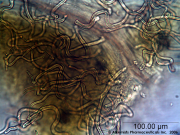Nomenclature
Filipendula ulmaria (L.) Maxim. Rosaceae
Syn. Spiraea ulmaria L.
Standardized common name (English): meadowsweet
Macroscopic Entries
| Spiraea Ulmaria L. (Filipendula Ulmaria (L.) Maxim.),
commonly known as Queen of the Meadow, or Meadow-sweet and many if not all the species of this genus contain a colorless volatile oil, very similar to the oil of gaultheria, but composed mainly of salicylic aldehyde, with only smaller amounts of methyl salicylate.
A yellow, crystalline powder of a bitter taste, insoluble in water, slightly so in alcohol, readily soluble in ether, and having an acid reaction. Spiraeaic acid (now recognized as salicylic acid) (J. Pr. Chem., xix) was separated from the flowers of S. Ulmaria by Lowig and Weidmann.
The roots of probably most of the species contain tannic acid, gallic acid, and when fresh some of the volatile oils.
Source: United States Dispensatory (1918) [1]
|
|
|
|
Microscopic Entries
| Long tangled unicellular trichomes from lower epidermis observed at 400x with Acidified Chloral Hydrate Glycerol Solution.
Source: Elan M. Sudberg, Alkemist Laboratories [2]
|
|
|
|
HPTLC Entries
Other Points of Interest
Cite error: <ref> tags exist, but no <references/> tag was found

